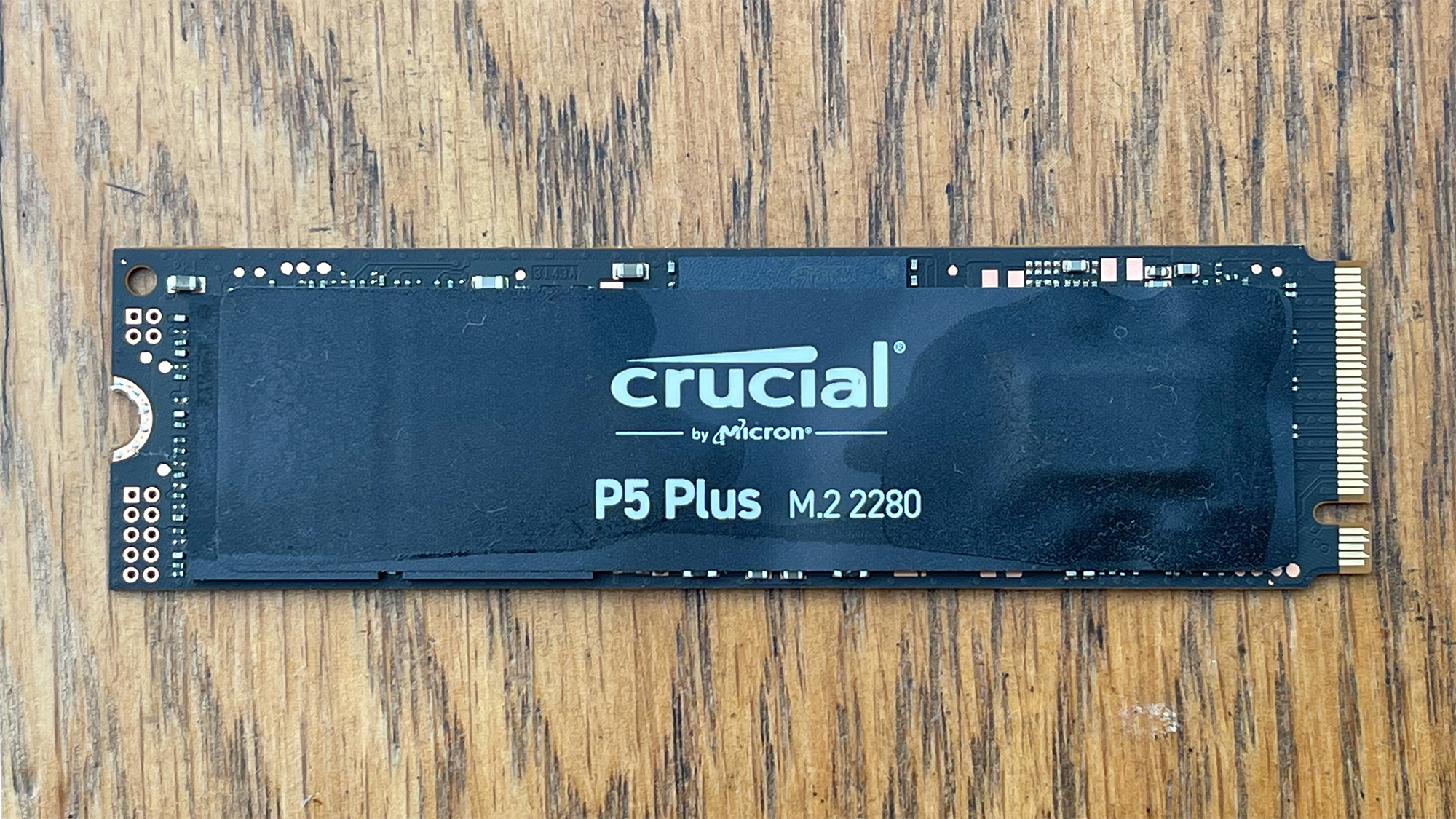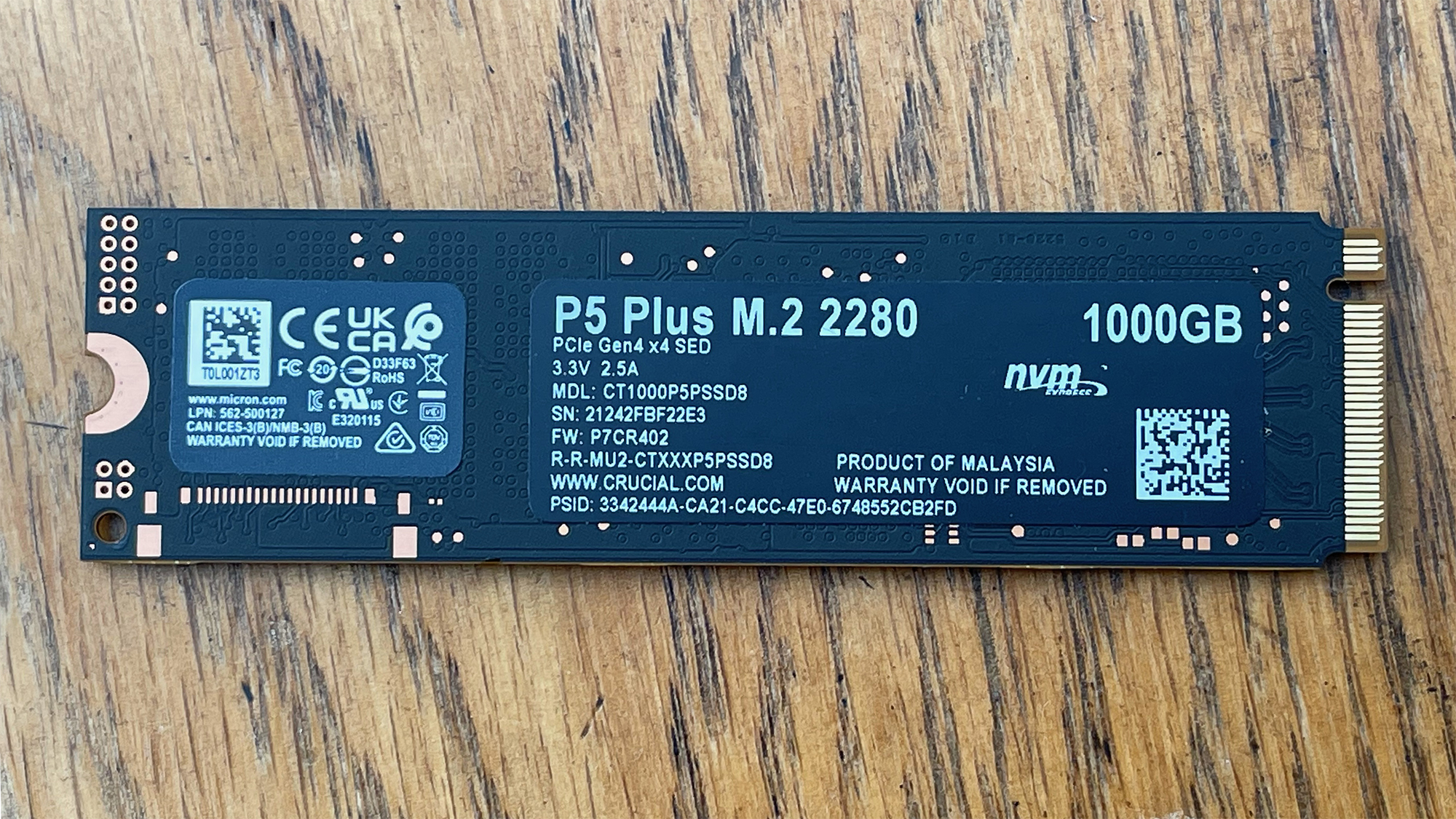Crucial P5 Plus 1TB review: PCIe 4.0 NVMe performance for less
Not the fastest PCI Express 4.0 NVMe M.2 drive in every metric, but solid real-world performance and great value


-
+
Notable speed upgrade over PCI Express 3.0 P5
-
+
Great value relative to competition
-
+
Solid reliability guarantees
-
-
Not the fastest PCI Express 4.0 M.2 NVMe drive in every test

For the past few years, AMD has had an advantage over Intel in several areas, and one of those has been storage speed. Its earlier adoption of the PCI Express 4.0 standard has meant it has been able to support the fastest NVMe drives available, while Intel was stuck with PCIe 3. But now the recently released 11th Generation of Intel processors (aka “Rocket Lake”) also supports PCI Express 4.0, making it high time to consider the upgrade. PCIe 4 drives are generally a lot more expensive than their PCIe 3 alternatives, but Crucial has a bit of a reputation for providing performance and quality for less. The P5 Plus continues that tradition into PCIe 4 NVMe SSDs.
There are considerable benefits on paper from the move to PCIe 4. The primary one is a doubling in bandwidth. Where SSDs smashed through the ceiling of SATA years ago, they have been nudging up against PCIe 3’s limitations recently too. The NVMe M.2 SSD standard supports up to four lanes of PCI Express, so with PCIe 3 you get 4GB/sec of bandwidth, but with PCIe 4 you can have 8GB/sec, and there are now SSDs out there that can deliver speeds close to this - at least for disk reads.
Crucial P5 Plus 1TB review: Capacities, speeds, and features
Crucial’s P5 Plus upgrades from the P5 we reviewed a year ago, promising 6,600MB/sec reading where the non-Plus version only delivered 3,400MB/sec. This is allied with 5,000MB/sec writing for the 1TB and 2TB versions, or 3,600MB/sec writing for the 500GB model. These are the three capacities currently available, with no 250GB option. The write speeds are a significant upgrade over the PCIe 3 P5 too, which only offered 3,000MB/sec writing.
Aside from the increase in performance, the P5 Plus continues the P5’s support for OPAL 2.0 full drive encryption. The drive comes with a five-year warranty promising a “Terabytes Written” guarantee of 300TBW for the 500GB drive, 600TBW for the 1TB drive, and 1,200TBW for the 2TB drive. Crucial also claims a two million-hour Mean Time To Failure (MTTF). The Flash memory technology used is Micron’s Advanced 3D NAND, which is a 176-cell TLC format. The TLC format means three bits per cell, compared to two for MLC and one for SLC. The drives come in the typical M.2-2280 format, so will fit most M.2 motherboard slots.
As we hinted in the introduction, one of the key things Crucial intends to do with the P5 Plus is make PCIe 4 M.2 more affordable. The 500GB version is £77.99 exc VAT, the 1TB version we were sent for testing is £130.99 exc VAT, and the 2TB version £266.99 exc VAT. Putting that in perspective, the Samsung 980 PRO is more expensive by around £20 for 500GB and 1TB capacities, and nearly £50 more for 2TB. The Seagate FireCuda 520 is also more expensive.
Crucial P5 Plus 1TB review: Performance

For testing, we installed the P5 Plus in an Interpro IPW-R9 workstation based around a 3.4GHz AMD Ryzen 9 5950X processor and with 64GB of DDR4 memory. Most Ryzen 9 motherboards only support one PCIe 4 M.2 drive, with the second one running at just PCIe 3 speed, but this system’s ASUS Crosshair VIII Dark Hero motherboard can host two M.2 storage devices with full PCIe 4 speed. The system’s boot drive was a 2TB Samsung 980 PRO.
In raw performance terms, the P5 Plus is fast but not as fast as the Samsung 980 PRO in every respect. The Crucial drive delivered sequential reading with the AS SSD benchmark of 4,794MB/sec and writing of 4,687MB/sec, compared to 5,529MB/sec reading and 4,026MB/sec writing, so it wins on writing but loses on reading. However, the 4K results were 64MB/sec reading and 149MB/sec writing for the P5 Plus, versus 82MB/sec and 212MB/sec for the 980 PRO, making the latter the faster drive with smaller files.
With PC Mark 10, however, the P5 Plus was comparatively better, achieving 3,073 in the Full System Drive Benchmark, compared to the Samsung’s 2,896. In the Data Drive Benchmark, the P5 Plus managed 4,796 compared to the Samsung’s 4,018. The P5 Plus’s Drive Consistency result was a solid 1,398. This writes 23TB plus three times the capacity to the drive, so 26TB in the case of a 1TB drive, and takes about a day to complete.
Overall, this drive will be great as a boot and application drive, with very quick software loading. It would be good for media editing, too, but probably overkill as for this workload you’ll likely want to trade cost and capacity for sheer speed.
Crucial P5 Plus 1TB review: Verdict
Although the Crucial P5 Plus lags behind the Samsung 980 PRO for raw reading speeds and small file access, it is faster for writing, and outperforms in the PC Mark 10 storage benchmarks as well. The Samsung drive is admittedly one of the fastest SSDs you can currently buy, but you pay a premium for it, particularly at 2TB capacity. Overall, then, the Crucial P5 Plus is a solid PCIe 4 NVMe drive and a great value option to supercharge your storage performance.
Crucial P5 Plus 1TB review specifications
| Capacity | 1TB |
| Cost Per Gigabyte | 15.7p |
| Interface | NVMe |
| Claimed Read | 6,600MB/s |
| Claimed Write | 5,000MB/s |
| Warranty | Five years RTB |
| Details | uk.crucial.com |
| Part Code | CT1000P5PSSD8 |
Get the ITPro daily newsletter
Sign up today and you will receive a free copy of our Future Focus 2025 report - the leading guidance on AI, cybersecurity and other IT challenges as per 700+ senior executives
Dr James Morris has worked as a technology journalist for over 25 years, including spending nine years on the staff of market-leading computer magazine PC Pro, the last five of which were as the publication’s editor. He specialises in enterprise-grade software and hardware, with a particular focus on content creation. He launched a pioneering video channel for HEXUS.net in 2006 and ran the video reviews channel for TrustedReviews.com for four years. He also runs a successful online digital content and commercial video production company, t-zero communications Ltd.
Dr Morris is a prolific technology writer and contributes commercial content for major IT brands including AMD, BlackBerry, Dell, Cognizant, HP, and IBM. He published a book on artificial intelligence, Can Computers Create Art? in 2009. He is also an academic, and is currently Pathway Director of the MA, Interactive Journalism at City, University of London.
Previously, he was course leader for the BA in Web Media Production at Ravensbourne University. He has a PhD in Philosophy, Art and Social Thought from the European Graduate School in Switzerland, a Master's in Media Arts from the New School in New York, USA, and a Bachelor's in Social Anthropology from the London School of Economics.
Dr. Morris can be found on Twitter at @Cyberwest, or emailed at j@tzero.co.uk
-
 ‘Phishing kits are a force multiplier': Cheap cyber crime kits can be bought on the dark web for less than $25 – and experts warn it’s lowering the barrier of entry for amateur hackers
‘Phishing kits are a force multiplier': Cheap cyber crime kits can be bought on the dark web for less than $25 – and experts warn it’s lowering the barrier of entry for amateur hackersNews Research from NordVPN shows phishing kits are now widely available on the dark web and via messaging apps like Telegram, and are often selling for less than $25.
By Emma Woollacott Published
-
 Redis unveils new tools for developers working on AI applications
Redis unveils new tools for developers working on AI applicationsNews Redis has announced new tools aimed at making it easier for AI developers to build applications and optimize large language model (LLM) outputs.
By Ross Kelly Published
-
 Google layoffs continue with "hundreds" cut from Chrome, Android, and Pixel teams
Google layoffs continue with "hundreds" cut from Chrome, Android, and Pixel teamsNews The tech giant's efficiency drive enters a third year with devices teams the latest target
By Bobby Hellard Published